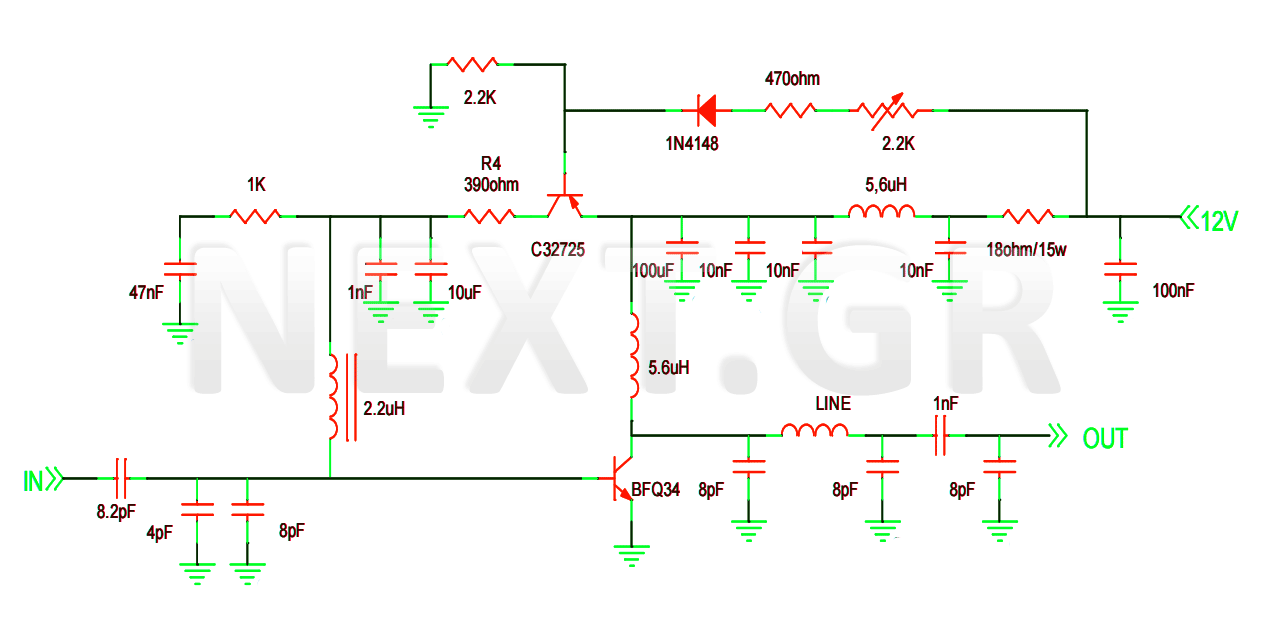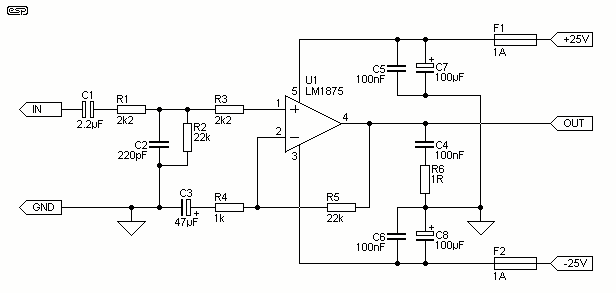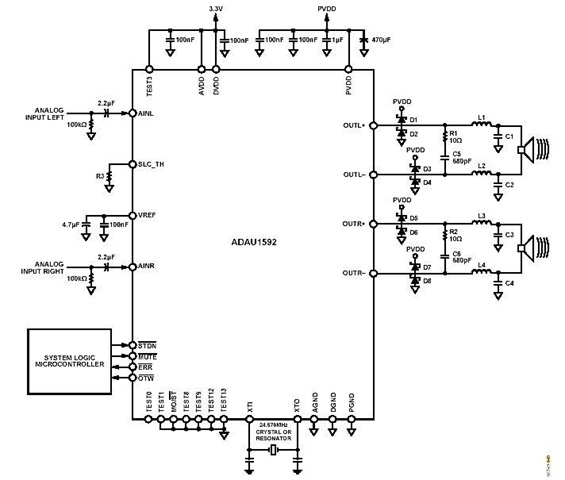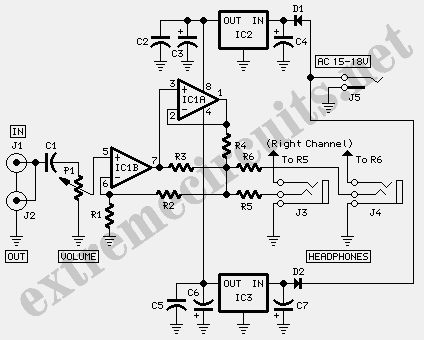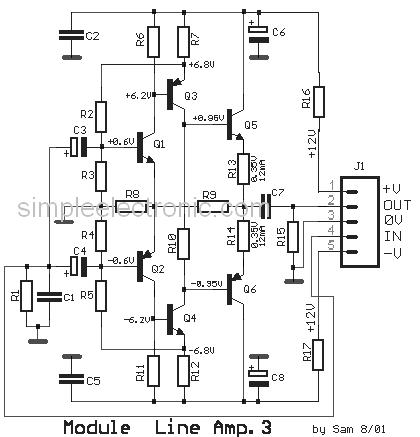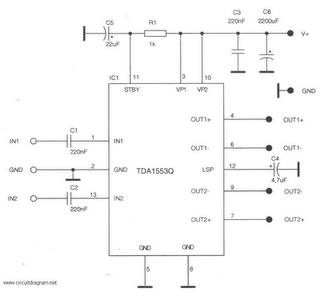
125Watt 150Mhz amplifier
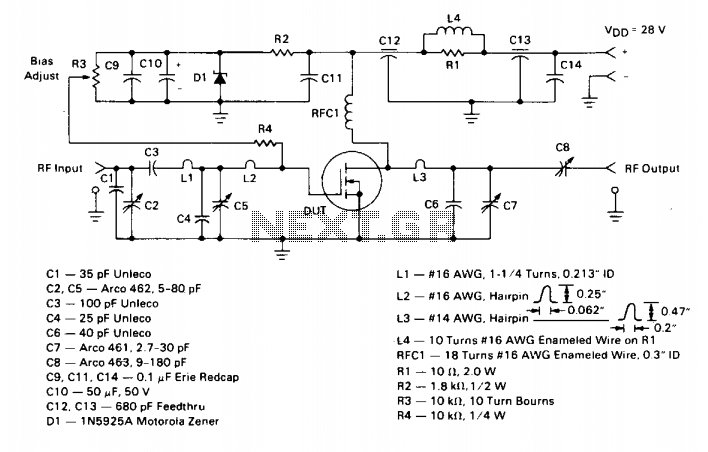
This amplifier operates from a 28 V DC supply. It has a typical gain of 12 dB and can withstand operation into a 30:1 VSWR load at any phase angle without sustaining damage. This indicates that with the input power maintained at a level that yields 125 watts output, the output power can be decreased to less than 1.0 watt continuously by applying a negative voltage to the DC gate from its Idq value. Additionally, the amplifier features an Automatic Gain Control (AGC) range exceeding 20 dB.
The amplifier circuit is designed to function efficiently under a 28 V DC power supply, making it suitable for various applications requiring robust performance. The gain of 12 dB signifies that the amplifier can increase the power level of the input signal by a factor of approximately 4, thus enhancing the signal strength for further processing or transmission.
The ability to operate into a 30:1 Voltage Standing Wave Ratio (VSWR) indicates that the amplifier is highly resilient to mismatched loads, a critical feature in RF applications where impedance matching is often challenging. This capability ensures that the amplifier can handle reflected power without incurring damage, which is essential for maintaining operational reliability in real-world scenarios.
The output power management is particularly noteworthy. The design allows for the output power to be significantly reduced, down to less than 1 watt, while maintaining a constant input power level. This is achieved by adjusting the DC gate voltage negatively from its quiescent drain current (Idq) value. Such a feature is beneficial for applications that require dynamic power control, enabling the amplifier to adapt to varying operational conditions without compromising performance.
Furthermore, the Automatic Gain Control (AGC) feature, with a range exceeding 20 dB, allows the amplifier to automatically adjust its gain based on the input signal level. This ensures consistent output performance across a wide range of input signal strengths, enhancing the versatility of the amplifier in different operational environments. The AGC system contributes to overall system stability and prevents distortion or clipping of the output signal, making the amplifier suitable for high-fidelity applications.
In summary, this amplifier is engineered for high performance, resilience to load variations, and effective power management, making it ideal for demanding electronic applications.This amplifier operates from a 28 Vdc supply. It has a typical gain of 12 dB, and can survive operation into a 30:1 VSWR load at any phase angle with no damage. This means that with input power held constant at the level that provides 125 watts output, the output power may be reduced to less than 1.0 watt continuously by driving the dc gate voltage negative from its Idq value.
The amplifier has an AGC range in excess of 20 dB.
The amplifier circuit is designed to function efficiently under a 28 V DC power supply, making it suitable for various applications requiring robust performance. The gain of 12 dB signifies that the amplifier can increase the power level of the input signal by a factor of approximately 4, thus enhancing the signal strength for further processing or transmission.
The ability to operate into a 30:1 Voltage Standing Wave Ratio (VSWR) indicates that the amplifier is highly resilient to mismatched loads, a critical feature in RF applications where impedance matching is often challenging. This capability ensures that the amplifier can handle reflected power without incurring damage, which is essential for maintaining operational reliability in real-world scenarios.
The output power management is particularly noteworthy. The design allows for the output power to be significantly reduced, down to less than 1 watt, while maintaining a constant input power level. This is achieved by adjusting the DC gate voltage negatively from its quiescent drain current (Idq) value. Such a feature is beneficial for applications that require dynamic power control, enabling the amplifier to adapt to varying operational conditions without compromising performance.
Furthermore, the Automatic Gain Control (AGC) feature, with a range exceeding 20 dB, allows the amplifier to automatically adjust its gain based on the input signal level. This ensures consistent output performance across a wide range of input signal strengths, enhancing the versatility of the amplifier in different operational environments. The AGC system contributes to overall system stability and prevents distortion or clipping of the output signal, making the amplifier suitable for high-fidelity applications.
In summary, this amplifier is engineered for high performance, resilience to load variations, and effective power management, making it ideal for demanding electronic applications.This amplifier operates from a 28 Vdc supply. It has a typical gain of 12 dB, and can survive operation into a 30:1 VSWR load at any phase angle with no damage. This means that with input power held constant at the level that provides 125 watts output, the output power may be reduced to less than 1.0 watt continuously by driving the dc gate voltage negative from its Idq value.
The amplifier has an AGC range in excess of 20 dB.
